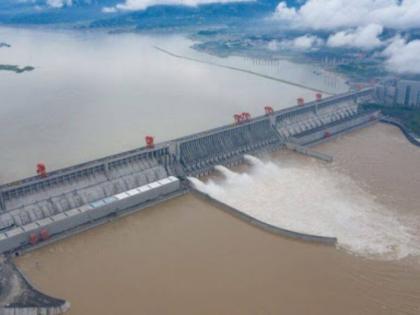After ‘Cloud Bomb’, ‘Water Bomb’ Now?
By Vijay Darda | Updated: July 28, 2025 06:49 IST2025-07-28T06:48:47+5:302025-07-28T06:49:20+5:30
From cloudburst in Leh to coronavirus, China is under cloud; is the dam on Brahmaputra its new weapon now?

After ‘Cloud Bomb’, ‘Water Bomb’ Now?
China is intimidating the world. It is instilling fear. The word humanity doesn’t even exist in its dictionary! The question is how do we deal with it?
The general global consensus about China has always been that it can go to any extent to destroy others. That’s why China is always viewed with suspicion. Just last week, Chinese Premier Li Qiang laid the foundation of the world’s largest dam on the Yarlung Tsangpo river in Tibet. This sparked concern from India to Bangladesh as to whether China will now use this dam as a new kind of weapon, a ‘water bomb’?
There is a solid reason behind this suspicion. The Yarlung Tsangpo river, after flowing through Tibet, enters India as the Brahmaputra river. Originating from the Kailash region of the Himalayas, it travels almost 2,900 kilometres before merging into the Bay of Bengal. In India, it covers a distance of around 996 kilometres. In recent years, the flow of this river in the northeastern region has decreased, and it has long been suspected that China is doing something upstream. This dam project has been under discussion for several years. It is said to be Chinese President Xi Jinping’s dream project. However, environmental experts around the world have opposed any such dam because it is being constructed near the Tibet-India border, and its sheer size poses a massive threat to the environment. Not only will Tibet be devastated, but India and Bangladesh’s fragile plateaus and low-lying plains will also be badly affected. Satellite imagery specialist Damien Symon has shared the dam’s exact location, which clearly shows that it is being built right near the Arunachal Pradesh border. China claims the project will include five hydroelectric power plants. The estimated cost of construction is around `14,473 billion. China says the dam is for green energy.
But India doesn’t believe that at all. Indian experts view this dam as a new weapon being built against India. The biggest concern is that once the dam is completed, China will control the flow of the Brahmaputra river entirely at will. Talking about any agreements is pointless as China doesn’t listen to anyone in the world. It can cause drought in the Brahmaputra basin whenever it wants, or trigger floods at will. The biggest threat experts warn of is the so-called ‘water bomb’. If China were ever to release massive volumes of water all at once towards India, what would happen? It would lead to catastrophic flooding from Arunachal Pradesh down to Assam! That’s why experts are suggesting that India should start preparing now so that if China ever created such a crisis, we can protect ourselves.
As I mentioned earlier, there aren’t just one but several reasons to suspect China. The memory of Covid-19 still lingers, when the entire world came to a standstill. The coronavirus that originated from China’s Wuhan city claimed the lives of more than 1.5 crore people across the globe. Even today, the world suspects that the virus was created in a Chinese laboratory. The Chinese doctor Li Wenliang, who first warned of the outbreak, was silenced by the police. He himself later fell victim to the virus.
Now, let me remind you of an incident that you may have forgotten or perhaps the new generation may not even know about. The date was August 6, 2010, and the place was Leh. Those who have travelled to Leh or read about the region would know that though clouds are often seen drifting in the clear blue skies, the natural conditions there result in less than four inches of rainfall annually. From November to April, the area is covered in thick snow, but rainfall is always scarce. The Ladakh region is known as a cold desert. Leh is a town in this region, and in 2010, it received more than 14 inches of rainfall in just two hours. Since the mountains in the area have less shear strength and such intense rainfall is unheard of, the downpour turned into a disaster, killing over 250 people and injuring hundreds more.
Naturally, you might wonder what role could China have possibly played in a cloudburst? Well, let me take you back to another event. In 2008, when the Beijing Olympics were being held, weather forecasters had predicted rains during the opening ceremony. Everyone was concerned. But China fired more than a thousand rockets filled with silver iodide into the clouds and caused them to rain outside of Beijing. It is widely believed that in China, clouds don’t cause rains where they please. They cause rains where China wants them to! So the suspicion still remains: Did China use clouds as a weapon in Leh? If it can manipulate clouds, then turning a river into a “water bomb” is certainly within its capabilities. The trouble, however, would be ours. That’s why we must start working right now to find ways to defuse this water bomb in advance.
I would also like to say one more thing that China wants to become a global superpower. Just like the US and Russia used fear and intimidation in their pursuit of dominance and continue to do so in various ways, China too is trying to create fear. I don’t blame China for this ambition, but the real question is one of humanity. And China seems hell bent on destroying that very humanity. The situation is becoming really terrifying.
Open in app